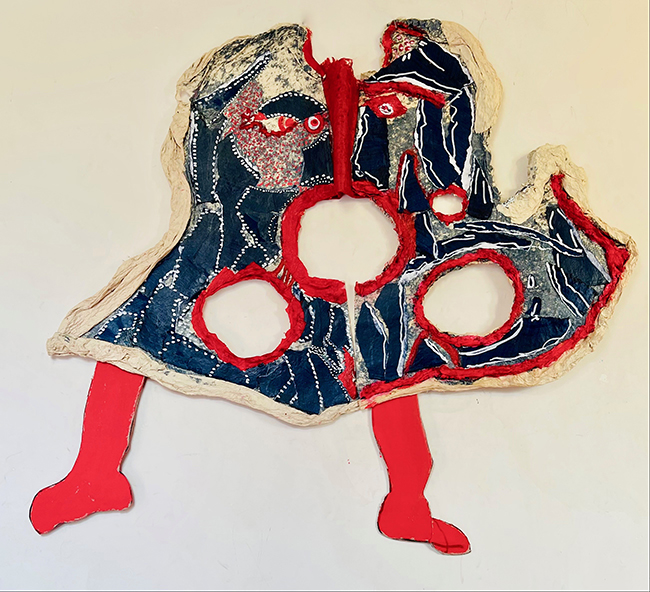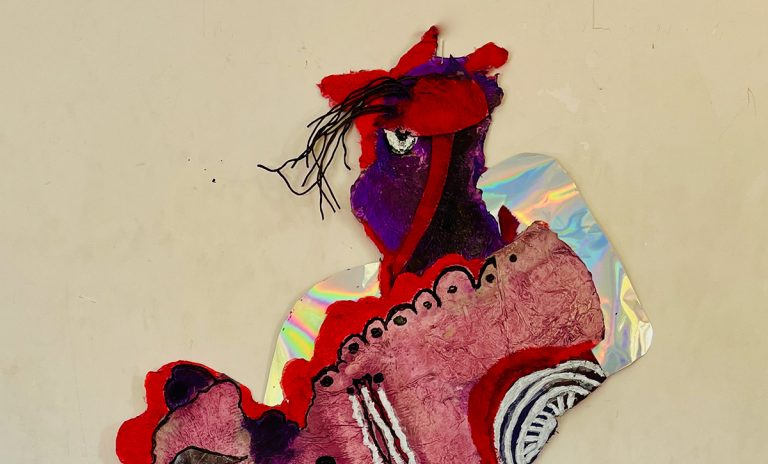Aliza Thomas is an artist and papermaker based in the Netherlands but originally from Israel, whose work is deeply rooted in the traditions of Asian papermaking and shamanic art. She is also a dedicated teacher of Qigong and Taiji Quan, disciplines that emphasize the harmony of mind, body, and spirit. Aliza’s art reflects her connection to these ancient practices, blending physical craft with spiritual insight. Her approach to creativity is as much about the process as the result, embodying a dialogue between the tangible and the metaphysical. Her handmade paper pieces explore themes of duality, balance, and the human experience. These works are deeply personal yet universal, evoking the rich, meditative qualities of her background in Eastern philosophy and martial arts.
Aliza’s work often reflects a dance between contrasts—light and dark, left and right, physical and spiritual. Two of her recent pieces, “Combining Left and Right” and “Carrying a Heavy Load,” exemplify this interplay, showing how her art transcends the medium to explore themes that are both deeply introspective and widely relatable.
Completed in 2024, this free-formed Kozo paper piece (122 cm x 110 cm) draws you in with its tactile quality and poetic undertones. The dyed pulp, shaped on a screen, creates a layered narrative about duality. Aliza’s accompanying verse—“Is it left or right? Who’s first? Your left or my right…”—invites viewers to reflect on perception and perspective. This piece isn’t just about literal directions; it’s about relationships, choices, and how we see ourselves in relation to others.

Aliza’s exploration of “left and right” stems from her experiences in martial arts and her observations of people. She describes the act of studying these sides as both therapeutic and endlessly inspiring. The twisting, snake-like forms in the piece suggest movement and tension, reflecting the push-pull dynamics of balance. The light slicing through the work symbolizes clarity amidst complexity, while the knots represent the challenges of navigating this duality.
One intriguing layer is the way Aliza views the interplay of left and right as a conversation. In her words, “You borrow my left side. Then I will be right.” This reciprocity is central to the work’s meaning—acknowledging the interconnectedness of opposites, whether in physical coordination or emotional exchange. The handmade Kozo paper itself, with its organic imperfections and rich texture, embodies this harmonious imbalance.
Created in 2020, this piece (133 cm x 68 cm) utilizes dyed Kozo pulp on a giant screen to capture a theme that is both timeless and poignant: the act of carrying. Inspired by Aliza’s admiration for the strength and grace of those who bear heavy burdens—whether animals, people, or even objects—the work highlights the duality of effort and ease.

Aliza reflects on how horseback riding evokes this feeling of being carried. She sees the pride and resilience in both the bearer and the one being carried. This sentiment shines through in the composition, where layers of Kozo pulp form shapes that suggest weight and motion. The interplay of shadows and textures creates an almost sculptural effect, emphasizing the physicality of carrying.
What makes this piece different is its emotional accessibility. Aliza captures not just the labor of carrying but the surprising lightness and pride in being carried. This dual experience is a metaphor for how we navigate life’s challenges, sharing burdens and finding strength in connection.
Kozo paper, a staple of traditional Japanese papermaking, is integral to Aliza’s work. Its strength and versatility make it an ideal medium for her explorations of form and texture. The process of making Kozo paper itself is a meditation—stripping bark, boiling, and shaping it into something both fragile and enduring. For Aliza, this process mirrors the themes she explores in her art: transformation, resilience, and balance.
Aliza Thomas’s art is more than an aesthetic experience—it’s a dialogue between the physical and the spiritual. Through works like “Combining Left and Right” and “Carrying a Heavy Load,” she invites viewers to consider their own relationships with duality and balance. Whether through the poetic interplay of light and shadow or the tangible weight of her subjects, Aliza’s work resonates on multiple levels.
Her practice, rooted in the traditions of papermaking and martial arts, offers a unique lens on the human condition. It’s a reminder that art isn’t just about the final piece; it’s about the process, the philosophy, and the connections we make along the way.

